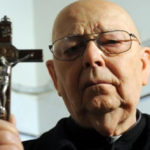 Animals
Animals  Animals
Animals  Weird Stuff
Weird Stuff 10 Weird Things People Used to Do at New Year’s
 Our World
Our World 10 Archaeological Discoveries of 2025 That Refined History
 Weird Stuff
Weird Stuff 10 Fascinating Facts You Might Not Know About Snow
 Miscellaneous
Miscellaneous Top 10 Things Crypto Was Supposed to Change & What Actually Did
 History
History 10 Huge Historical Events That Happened on Christmas Eve
 Music
Music 10 Surprising Origin Stories of Your Favorite Holiday Songs
 History
History 10 Less Than Jolly Events That Occurred on December 25
 Weird Stuff
Weird Stuff 10 Funny Ways That Researchers Overthink Christmas
 Politics
Politics 10 Political Scandals That Sent Crowds Into the Streets
 Animals
Animals 10 Species That Refused to Go Extinct
 Weird Stuff
Weird Stuff 10 Weird Things People Used to Do at New Year’s
 Our World
Our World 10 Archaeological Discoveries of 2025 That Refined History
Who's Behind Listverse?

Jamie Frater
Head Editor
Jamie founded Listverse due to an insatiable desire to share fascinating, obscure, and bizarre facts. He has been a guest speaker on numerous national radio and television stations and is a five time published author.
More About Us Weird Stuff
Weird Stuff 10 Fascinating Facts You Might Not Know About Snow
 Miscellaneous
Miscellaneous Top 10 Things Crypto Was Supposed to Change & What Actually Did
 History
History 10 Huge Historical Events That Happened on Christmas Eve
 Music
Music 10 Surprising Origin Stories of Your Favorite Holiday Songs
 History
History 10 Less Than Jolly Events That Occurred on December 25
 Weird Stuff
Weird Stuff 10 Funny Ways That Researchers Overthink Christmas
 Politics
Politics 10 Political Scandals That Sent Crowds Into the Streets
10 Strange Phenomena That Stumped Experts
The unknown doesn’t tend to stay unknown. After all, there are quite a few very smart people out there, constantly endeavoring to document and understand our world and its mysteries. Often, they’re the ones to turn to when something seems inexplicable.
We rely on experts for answers, but sometimes, they’re as baffled as we are when strange phenomena are encountered. Whether they’re objects or events, such phenomena often strike us as odd, eerie, bizarre, fantastic, incredible, marvelous, or even revolting and remain puzzling until they’re identified and understood, if they ever are. These ten strange phenomena that stumped experts are no exceptions to the rule.
10 Bone Irrigator

In 2010, when a mysterious object was first discovered during an excavation of the grounds at New York’s City Hall, stumped archaeologists were unable to identify it. Found in a pile of rubbish, among beer bottles and the bones of a cow that had supplied food for a feast, the tubular bone object, a thin cylinder with screw threads on either end, a perforated lid, and a cap with a hole in its center, mystified experts.
In search of an answer, scientists theorized the object might be “a spice grinder or needle case,” said Alyssa Loorya, president of Chrysalis Archaeology, the firm supervising the excavation as part of a rehabilitation project. “We were stumped,” she admitted.
The strange artifact was identified after one of Loorya’s team members, Lisa Geiger, saw a similar object while she was at work in a Philadelphia museum. It was a vaginal syringe, or irrigator. 19th-century women used them to prevent pregnancy, to clean themselves, or to treat sexually transmitted diseases. Similar irrigators were found in a brothel outhouse during an archaeological dig in Boston. The devices weren’t only used by prostitutes; women of every socioeconomic stratum also employed the irrigators, and in New York, women gave them to each other as wedding presents.[1]
9 Buried Bones

A 9,300-year-old skull buried with the skeletal remains of severed hands, the left covering the right side of the head and pointing up, the right covering the left side of the head and pointing down, was found in Brazil. Although they understood the remains were those of a victim of ritual sacrifice, archaeologists were baffled as to the meaning of the arrangement of the skull and hands.
In 2007, Andre Strauss, a researcher with Max Planck Institute of Evolutionary Anthropology, found the strange display buried beneath a rock. Strontium isotope analysis showed the bones belonged to a young man local to Brazil’s Lapa do Santo area. He suffered a horrific and agonizing death, experts said. The way his neck vertebrae were fractured indicated that his head was not completely severed by the blow of a blade, and “the remaining muscle and tissue was then twisted and torn to remove it from the body.” The flesh was not flayed from his body, and no evidence suggested the head and hands were mounted as a display.
Although amputated hands sometimes signaled punishment and warned of the results of violating social norms and was a way by which to disgrace conquered enemies, the skull’s condition does not correspond to either of these possibilities, and archaeologists remain stumped as the the meaning of the strange display.[2]
8 Canine Suicides

“Dogs do not commit suicide,” said Doreen Graham of the Scottish Society for the Prevention of Cruelty to Animals. Except in Scotland, apparently, they do. Once a prosperous town, Dumbarton, which has become little more than a suburb on the outskirts of Glasgow, can seem depressing on a gloomy day. Even the dogs seem to be feeling down, and in February and March of 2005, some leaped to their deaths from a bridge dubbed “rover’s leap.”
In one case, a woman’s dog leaped over the bridge’s parapet, plummeting 12 meters (40 ft) to its death. The woman, who was shocked by the incident, had no idea why her beloved canine companion would have done such a thing, nor did anyone else.
Four other dogs have also jumped off the bridge, with the same results. Strangely, they all leaped from the same spot. Animal behaviorist Joyce Stewart called for an investigation of the phenomenon. Although she said canine suicide isn’t something she’s ever heard of, the dogs’ behavior is certainly “abnormal.” She speculated that the animals might have experienced an optical illusion that interfered with their normally good ability to judge distances. According to Stewart, “From photographs of the bridge, it would appear that the tree canopy rises above the bridge and it may cause some sort of confusion to the animal, which thinks it is jumping to something solid.”
“The incidents at the bridge are of very great concern to us because we would like to understand why they are happening,” said Graham, despite Stewart’s hypothesis. Animal behaviorists were unable to explain the dogs’ bizarre behavior, and animal welfare experts advised pet owners to keep their dogs leashed.[3]
7 Hidden Geoglyphs

2,000-year-old geoglyphs, the size of city blocks, form circles and squares across thousands of acres in the Brazilian Amazon.[4] The ancient earthworks, which include trenches 11 meters (36 ft) wide and 4 meters (13 ft) deep, remained hidden until the 1980s, when farmers cleared land to raise cattle. Archaeologists are puzzled by the gigantic geoglyphs, the purpose of which remains unknown.
The discovery of the designs calls into question the idea that humans left the Amazon’s rain forests alone until European explorers arrived in the 15th century. Now, it seems local people were managing the forests using “sustainable agricultural processes.” As noted by Jennifer Watling, who conducted the research as a student at the University of Exeter in Britain, “A lot of people have the idea that the Amazon forests are pristine forests, never touched by humans, and that’s obviously not the case.”
6 Godzillus

Uncovered in 2011 by amateur paleontologist Ron Fine, 43, of Dayton, Ohio, the bizarre 70-kilogram (150 lb) fossil known as “Godzillus” continues to mystify scientists. Discovered in Northern Kentucky, the 450-million-year-old fossil is 1.8 meters (6 ft) long and 0.9 meters (3 ft) wide and resembles a group of concrete stepping stones. Scientists don’t know whether the fossil is that of an animal or a plant. According to University of Cincinnati geologist Carl Brett, Godzillus is the biggest fossil of its era ever to have been removed from the Cincinnati region.
Fine suggests the fossil could be ancient kelp or seaweed, but David Meyer, another UC geology professor said, “This one has us stumped.” While the fossil isn’t that of a fish, Meyer’s guess is that it might be the remains of a sponge, noting the area in which Fine found Godzillus was “covered by a sea, 100 to 200 feet deep.” But his guess is just that: a guess. Experts don’t know for certain what Fine discovered when he found the remains of Godzillus.[5]
5 Mesodinium Chamaeleon
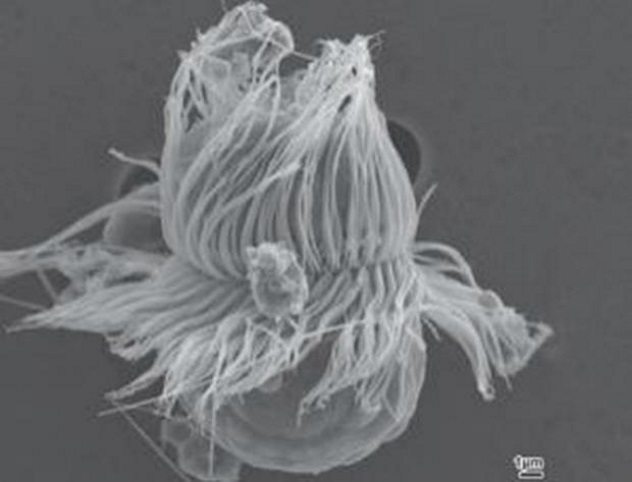
Microscopic in size, Mesodinium chamaeleon has scientists stymied. It’s not a plant, but it’s not an animal, either. As an animal, it uses its hair-like cilia to swim about, devouring plants. After feeding, it turns into a plant itself and is able to photosynthesize. After a while, it consumes the chlorophyll granules it obtained by eating the plant and reverts into an animal to begin the process of transformations anew. The bizarre creature dwells at the bottom of the ocean. In 2012, it was discovered off the coast of Copenhagen, Denmark.
Scientists are mystified by it. They can’t describe it in detail, and they haven’t been able to determine the amount of energy it obtains from photosynthesis. They also don’t know why it eats the chlorophyll granules it acquires. Further discoveries await “getting this animal-plant established in a culture in our laboratory,” says Ojvind Moestrup, a professor in the Marine Biological Section of the University of Copenhagen’s Department of Biology.[6]
4 Ancient Monument
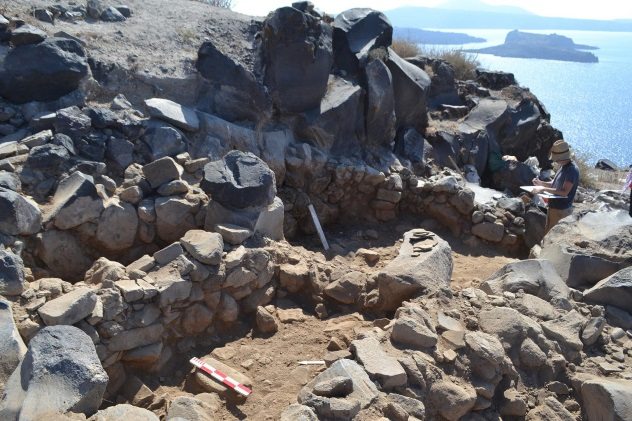
In 2017, archaeologists excavating a prehistoric settlement in Greece’s Thirassia, one of the Santorini islands, discovered a 2,200-year-old monument. Unable to determine its origin, experts from the the Ionian University, the University of Crete, and the Cycladic Antiquities Bureau were baffled.
According to the Greek Ministry of Culture and Antiquities, the oval-shaped monument is ornamented with numerous decorative features and might have been associated with a god, although which one, if any, remained unclear.[7]
3 Somerset Slime

Scientists were stumped by the strange jelly-like slime that appeared in a nature reserve in Somerset, England, in 2012. The bizarre substance was found in several locations. Experts were unable to explain its origin, although a few guesses were hazarded. The reserve’s spokesman, Tony Whitehead, suggested the slime might be Nostoc, a form of cyanobacteria.
Other guesses held it might be the regurgitated viscera of amphibians and their spawn. Whitehead said, in past centuries, the substance was “known variously as star jelly, astral jelly or astromyxin,” and folklore associated it with meteors. Other speculations suggested it lacked DNA, although it appeared to be alive. Experts didn’t know what to make of the slime. Visitors to the reserve were warned not to touch the substance, whatever it was.[8]
2 Strange Insect
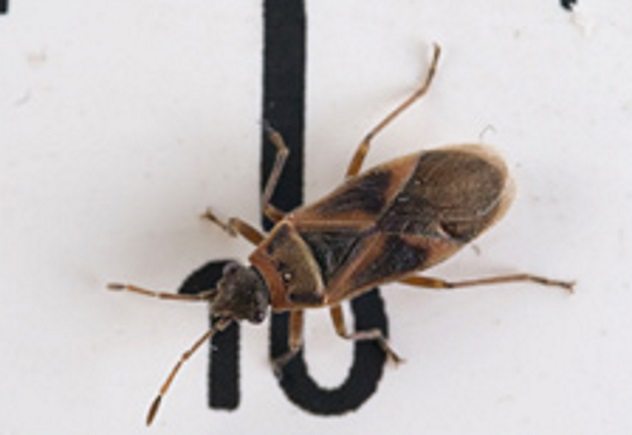
A mysterious insect that has stumped experts may be a newly discovered species. The bug, which is about the same size as a grain of rice, is black and red and was first seen in London’s Natural History Museum’s Wildlife Garden in 2007. Since then, it’s also been seen in Regent’s Park and Gray’s Inn. It’s already become “the most common insect in the [museum’s] garden” and could continue to spread throughout the United Kingdom.
The museum contains 28 million insect specimens, but none of them matched the strange bug, which looks most like Arocatus roselli, a rare species in Central Europe. However, the mystery bug is brighter than A. roselli, and A. roselli, unlike the unidentified insect, is associated with alder trees. “It seems strange that so many of these bugs should suddenly appear,” said Max Barclay, who works for the museum. Possibly, the insect is A. roselli, after all, and has multiplied and become invasive after feeding on plane trees instead of alder trees. If not, the insect could be a species never before encountered.[9]
1 Teenage Toddler
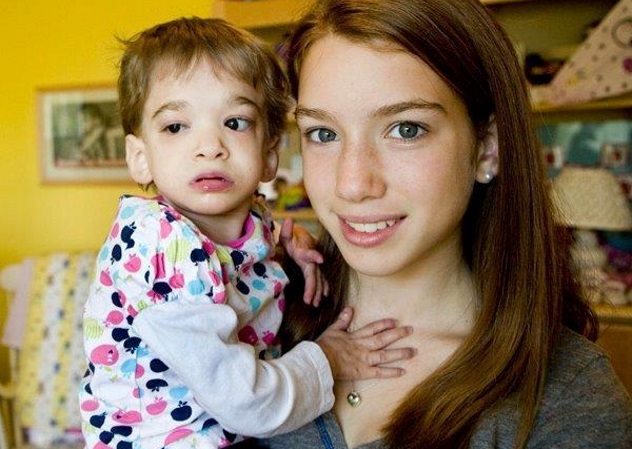
When she was 16 years old, Brooke Greenberg looked like a toddler. Neither doctors nor medical researchers knew why her body and her brain never grew or aged. Brooke also suffered from other contradictions. Her bones were those of a ten-year-old, and she still had her baby teeth. Her mental age was barely a year. She was never diagnosed with a genetic syndrome or a chromosomal abnormality. Due to her condition, she rode in a baby stroller, wore toddlers’ clothing, slept in a crib, and was entirely dependent on her parents’ care. Through her, scientists were hoping to learn more about how genetics affects and contributes to the aging process.
According to Johns Hopkins School of Medicine pediatrician Lawrence Pakula, Brooke’s condition may have been unique. “Many of the best-known names in medicine, in their experience [ . . . ] had not seen anyone who matched up to Brooke,” he said. Dr. Richard Walker of the University of South Florida College of Medicine, in Tampa, said that parts of Brooke’s body were developing in isolation of one another, rather than as parts of a whole, and that their development was “out of sync” with each other. Brooke had experienced only “very minimal changes” in her brain. She weighed only 7 kilograms (16 lb) and was only 76 centimeters tall (2’6″).
During her first six years, Brooke underwent surgery for seven perforated stomach ulcers and had other medical operations. She suffered a seizure after experiencing a stroke, but the event didn’t damage her brain. At age four, she was diagnosed with a brain tumor, but it disappeared on its own. Experts were stumped as to the cause of her illness. Growth hormone therapy proved ineffective. Only her hair and nails grew. Sadly, Brooke passed away in 2013, at age 20. She still physically resembled a toddler.
If doctors could have solved the mystery of the teen toddler’s agelessness, they may have been able to develop the means to slow aging itself, a breakthrough that could have a variety of applications, including allowing astronauts to travel in space for a much longer time than they can now.[10]
Gary Pullman, an instructor at the University of Nevada, Las Vegas, lives south of Area 51, which, according to his family and friends, explains “a lot.” His 2016 urban fantasy novel, A Whole World Full of Hurt, available on Amazon.com, was published by The Wild Rose Press.
For more mysteries that baffled the experts, check out 10 Biological Mysteries That Continue To Baffle Scientists and 10 Fascinating Mysteries Of Life That Science Can’t Explain.





